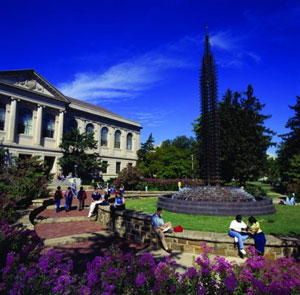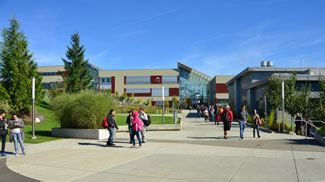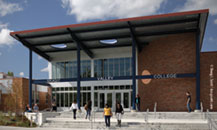
Find programs in Arts and Design
Art, Music, Dance, Design, Painting and more
Artistic people may not look the same, understand each other’s language or culture, but they share a common instinct—the desire to create. This desire begins in their imagination, but their tools for design can differ dramatically. While a painter uses brushes and paint, a digital animator uses computers and advanced software. If you have a passion to design and create the United States has excellent fine arts and design programs, some of the best in the world.
Wide Variety of Programs
You can find a wide variety of arts programs to suit your interests in many regions of the United States. For example, the USA is at the forefront of the digital arts revolution. Digital media and the expanding entertainment industry are creating a strong market for new technology, creative concepts and fresh talent. This has given way to many more career opportunities for graphic designers, 3D animators, digital editors and the like, all of whom need a foundation in the fine arts.
The global success of special effects films has bolstered the position of the USA, California in particular, as a leader in digital arts, while New York City is at the center of the theatre arts scene. Why not study right near the pulse of the film industry?
Selecting a Program
“We can look at artwork from ancient antiquity to contemporary times in every corner of the world. Art is what we can use to get a glimpse of what beliefs, values, and ideals have been formed or challenged by societies. How amazing is that?”
“I think International students are wonderful because they are open to trying new things, which is crucial in working in the arts. You have to be willing to take chances and work hard for long periods of time often without success or compensation for your efforts.”
- David Roholt, Associate Professor of Art at Pierce College.
The school you choose should employ many practicing, successful artists and designers. You need a mentor who can not only teach you the theory of your discipline, but also help you gain the practical, real-world experience necessary for any career in the arts. Who better to learn from than professionals who are already established and recognized for their accomplishments?
Research the credentials of faculty members and read about their professional experience. You may even ask to speak with some of the professors or current international students. Gaining insight from those already in the program can be very helpful.
The school should also have a commitment to investing in new equipment, programs, and technology to keep up with the industry’s lightning-fast pace. Having knowledge and experience with the most current technical programs and equipment will make you more appealing to employers.
Internships, work experience and job placement are also important factors to consider. The school should have contacts within the industry and assist its graduates with placement through recruitment drives, portfolio reviews and workshops. Find out where the graduates are working and ask about the placement rate for recent graduates. Is there an alumni network in place to help new graduates find positions?
Lastly, the reputation of the school is important. Do professionals in the field speak highly of the school? Does it have accreditation through organizations like the National Association of Schools of Art and Design, or the Accrediting Council for Independent Colleges and Schools?
Pursuing your Goals
Admission to arts programs varies widely. Some schools require portfolios with examples of artwork or performance auditions, while others do not. You should also check whether TOEFL scores are necessary. Most schools greatly appreciate the diversity and unique dimensions that international students bring to campus.
Consider conducting informational interviews to learn more about the field. Interview someone who has a career in your chosen field. What steps do they recommend to obtain this goal? What do they wish they would have known when they were your age? No matter what the admission requirements are, take the time to select the program that is right for you.
As schools in the USA embrace new technology and ideas it has made the United States a uniquely creative place to study. If you have a passion for art and design, couple it with show-stopping professionalism and training, and the sky is the limit.
University of Arkansas School of Art
With degree programs offered in art history, studio art, art education, graphic design as well as studio design, students will find exactly what they are looking for when arriving at the University of Arkansas School of Art campus in Fayetteville, Arkansas. Whether they want to teach, pursue research, or actively work in the art and design field, the School of Art will provide students with the education, skills and training necessary to prepare graduates for meaningful employment in the arts.
Creativity, self-discipline, ambition, attention to detail, strong visual and aesthetic sense, communication, research and critical thinking are all skills that students learn and develop during their time in the program.
A recent generous award will allow the school to “be able to seek out the best faculty to provide the necessary and ongoing support to teach, learn, create, and expand our outreach from beyond the classroom and into our community, “says Jeannie Hulen, chair of the University School of Art.
The school was awarded a $120 million gift from the Walton Family Charitable Support Foundation. The gift propels the School of Art into a center of excellence in art education, art history, design and studio art curriculum. It is the largest such gift ever given to a U.S. university to support a school of art.
The gift will “transform the University and region into an international hub for the study of art,” explains Joseph E. Steinmetz, chancellor of the University of Arkansas.
Truckee Meadows Community College Graphic Communications Program
Visual communications have been known by various names over the years, including commercial art, graphic design, advertising design, publication design, graphic arts, and multimedia. For more than 25 years, Truckee Meadows Community College (TMCC) has offered graphics courses in a comprehensive program that culminates in a professional and commercial computer graphics certificate/degree program that has supplied the regional graphics industry with a trained and skilled workforce.
The program consistently produces the second highest number of graduates of Career and Technical Education programs at Truckee Meadows Community College, precisely because the graphics faculty and leadership recognize the program’s importance to employers. Additionally, the award-winning academic teaching faculty have earned a reputation as passionate instructors whose interest is in serving students, the institution, and the regional graphics industry.
The Graphic Communications program offers classes that lead to an associate degree or a certificate of achievement focusing on graphic design, web design, videography and animation. Instruction includes the latest theories and technologies, including the use of industry standard graphics software, and computer labs are equipped with the latest Apple computers with support scanners, color printers, a sound booth for creating and capturing audio, and a complete pre-press/print shop facility.
Every international student who has graduated from the program has gone on to complete Optional Practical Training (OPT). All students in the program learn how to create, produce and reproduce visual graphics that communicate to an audience, preparing them in a fulfilling and exciting career field.
University of Nevada, Reno’s Music Program
The conductor calmly raises his baton. There is silence in the hall as the audience quiets in expectation. In an instant, the silence is broken. The pianist’s fingers speed across the keyboard, pounding the keys with great might. In one section, bows race across strings and with deep breaths, musicians in another section blow into their instruments. Together, the University of Nevada, Reno’s Symphony Orchestra engulfs the Nightingale Concert Hall with Saint-Saens’ Piano Concerto No. 2.
The University of Nevada, Reno Department of Music is part of a lively School of the Arts. Students studying music are taught from faculty comprised of music performers, scholars, and composers. Professors and faculty personally guide and mentor students through the rigorous and challenging program.
The program is focused on building strong musical foundations, enabling students to develop their own musical “voice” and style. In addition to foundational courses, students can study unique history courses, such as Television Music, Jazz Cultures, and History of American Musical Theater.
Other than their courses, students have numerous opportunities to practice their music and perform. Private music lessons are offered and students can participate in chamber music settings and large ensembles (including the renowned Nightingale String Quartet), both on campus and in the community. There are many festivals throughout the year organized by the Music Department, including the Reno Jazz Festival, the Winter Chamber Music Festival and the Argenta Festival. The University also collaborates with the Reno Philharmonic Orchestra and Reno Chamber Orchestra.
Taking advantage of the many performance opportunities is international student and pianist, Bomin Park. He has been the Nevada state winner two years in a row of the Music Teachers National Association Competition, and was honored with the Dean’s Award for Artistic Achievement.
Students of the program are prepared to pursue careers in music, from teaching and performing, to musicology and composition. They can pursue Bachelor of Art degrees, Bachelor of Music Education, and Music Performance degrees, focusing on classical or jazz and improvisational music. The University also offers master’s degrees in Performance, Education, and Musicology.
Many graduates are now teachers in major graduate programs across the U.S., or are playing in orchestras, chamber groups, and jazz and popular music groups worldwide. Mezzo-soprano Dolora Zajick, for example, has enjoyed a career performing in the premiere opera houses of the world, including the Metropolitan Opera in New York, Chicago’s Lyric Opera, San Francisco Opera, and London’s Covent Garden.
Pierce College
Language barriers dissipate with a pencil and with a stroke of a brush, students enter a world in which creativity and expression are the common languages.
“Arts are the most universal way for us to learn about all cultures both far and near alike. In the visual arts there are no language gaps,” explains David Roholt, Associate Professor of Art at Pierce College.
At Pierce College, a community college south of Seattle in Lakewood, Washington, all students have the chance to explore fine arts, whether they plan to study fine arts, digital design, or even business. Drawing and painting classes are the most popular among international students.
Professors guide students through foundational courses in drawing, painting, basic sculpture and photography, giving one-on-one instruction.
“David Johnson: The best art teacher at Pierce in my mind. He was my photography teacher. He is knowledgeable, super kind, super helpful, super patient,” says Thomas Chen Zhen.
Zhen, an international student, won the Outstanding Art Student of the Year award. Zhen has been accepted to the DigiPen Institute of Technology, a private college focused on video game development. Zhen:
“My advisors gave me lots of encouragement and helped me to apply to Digipen.”
Pierce College students have also transferred to Cornish College of the Arts, Rhode Island School of Art and Design, University of Washington and the University of Colorado at Boulder.
At Skagit Valley College in Mount Vernon, Washington, farm-to-table isn’t just a philosophy, it’s a practice. Students in the Culinary Arts and Hospitality Management program plant and maintain gardens that produce fruits and vegetables for daily meals in the campus’ Bistro Kitchen and Hot Express.
“We are passionate about growing our own produce,” says Lyn Highet, the college’s Food Services Manager.
Founded in 1978, the program has diversified to incorporate agriculture and sustainable food systems and practices such as composting—Skagit was the first college to start a composting program. Skagit is also developing culinary artisan programs as Washington State boasts many nationally recognized artisan cheesemakers, charcutiers and brewers.
Students in the program master the culinary fundamentals and techniques such as making stocks from scratch for daily soups and grinding meat for hamburgers.
The area around Skagit Valley College is fertile and agriculturally rich, lending it to many farmers, of both land and sea, and culinary artisans. Students take fieldtrips to meet producers like the farmers at Taylor Shellfish Farms, the largest producer of Manila clams in the USA.
Students who complete the Culinary Arts and Hospitality Management program earn an Associate and Technical Arts degree. Many students either begin their careers or move on to advanced culinary programs.
AMDA College and Conservatory of the Performing Arts New York City and Los Angeles
There’s a reason New York City never sleeps.
The constant buzz of America’s largest city doesn’t just come from the lights of Broadway; it comes from the bohemian heritage of the West Village, the underground beats of Harlem and the arias soaring from the Met. Performers from every country and discipline are drawn to Manhattan to pursue their dreams.
Now it’s your turn.
When you attend AMDA New York, Broadway is your backyard. Our students are a vital part of the creative community here, and the city itself sets the scene for an innovative learning experience.
An AMDA education is more than just studio training; it’s a backstage pass to New York City’s performing arts scene. Every day, hundreds of films, television shows, dance concerts, symphonies, performance art pieces and plays are produced just steps from campus. And then, of course, there’s Broadway. You’re likely to find more AMDA students on Broadway stages than students from any other performing arts college, with alumni who fill the casts of Broadway production after Broadway production. You could be next.
It’s no surprise that Los Angeles is considered the entertainment capital of the world.
From searchlights sweeping the skies over the latest red carpet award ceremony to the world-class musicians cutting tracks at Capitol Studios, Los Angeles pulses with an unshakable sense that something big is always happening — probably because it is.For generations, artists from around the world have been drawn to Hollywood to pursue their creative passions.
Join them on your own path to success.
When you attend AMDA Los Angeles, you become a part of Hollywood’s creative community; the studios, theaters and landmarks are your inspiration. Hundreds of films, television shows and live performances take place here each day. With Hollywood as your classroom, you’ll get unrivaled behind-the-scenes access, face time with industry leaders, and, with many major film, television and recording studios just around the corner, a real understanding of how show business actually works. To get to class, you stroll down the Walk of Fame, each star proof positive that this is a town where dreams come true.






























